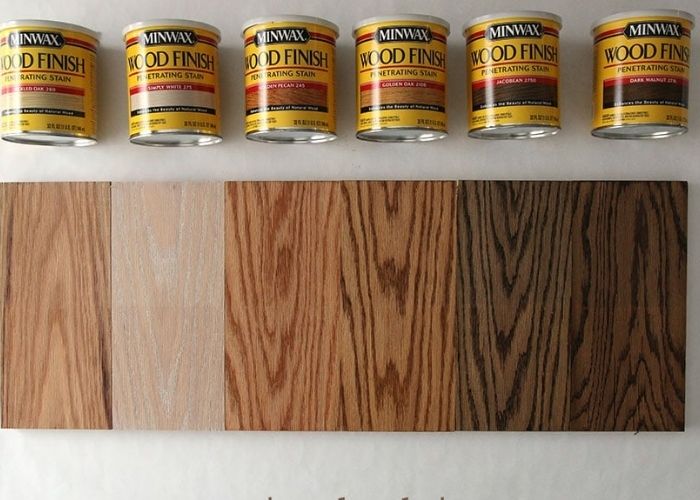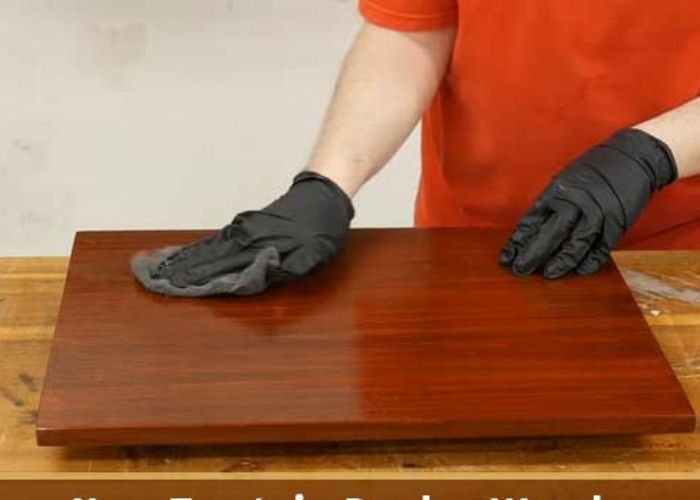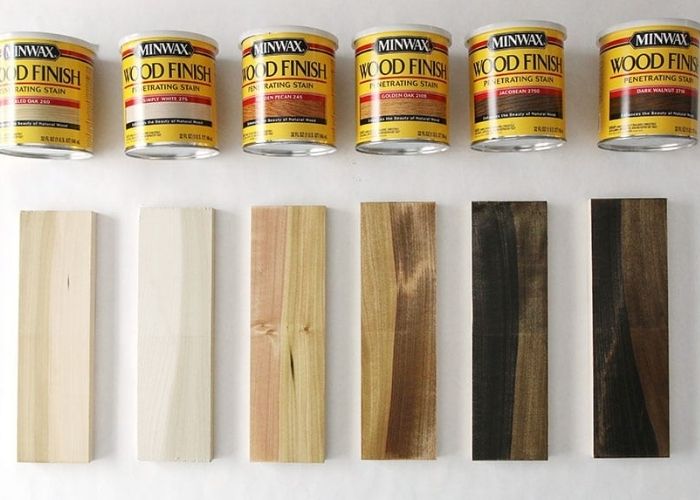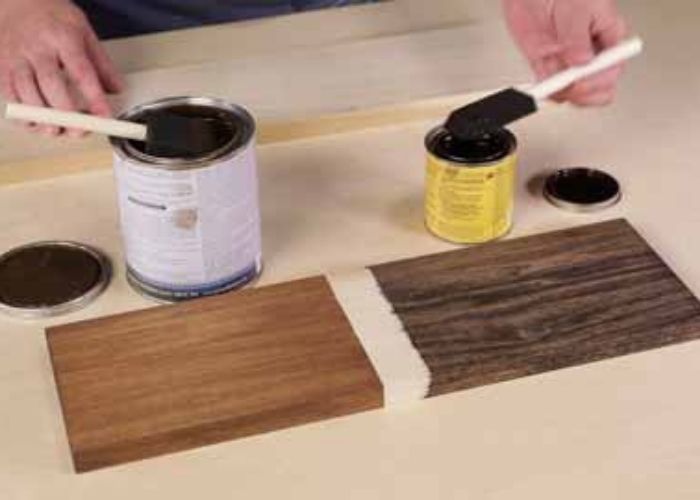Poplar is a very popular wood type among woodworkers. It’s one of the first options that come to mind whether you’re making cabinets, furniture, picture frames, or others.
And, why not when it’s one of the most available and cost-effective hardwoods? Although it has a few downsides, such as poor moisture resistance, the advantages far outweigh the downsides.
It’s very durable and is characterized by a relatively high density that gives it excellent bending strength. This guide assesses natural finishing solutions to add aesthetic value to your poplar furniture.
Put bluntly, what’s the best natural finish for poplar?
What’s the Best Natural Finish for Poplar?
The best natural finish for poplar wood is a gel stain or a wipe-on stain. Although poplar wood takes nearly all stains well, including penetrating stains or ones that need to soak deeply, gel stains let some of the wood’s unique markings and texture shine through while delivering a crisp, consistent finish not dissimilar to paint.
Advantages of Using a Poplar Finish
Wood finish benefits furniture in two main ways; protection and decoration. Protection means shielding wood from the effects of the immediate environment.
For instance, wood finish protects the underlying surface from moisture (humidity) and liquid water. It makes your wood surfaces safe if you accidentally spill water on the furniture.
Additionally, finishing protects wood; for example, workbench wood finishes protect it from scratches, dirt, and wear during wortk. The thicker the finish, the more resistant it is to wear. Of course, this prolongs the lifespan of the furniture.
Meanwhile, decoration means the finish showcases the wood’s natural beauty. It brings out the wood’s color, grain pattern, and depth, making the furniture stand out.
Simultaneously, finishing hides defects, such as dents, to enhance the appearance of wood.
Types of Wood Finishing

There are dozens of finishing options for wood, ranging from varnish to oil and shellac to wood dye. However, the most common finishes are;
- Varnish: Varnish is the most popular wood finish. It comes in transparent or colored options and typically comprises oil, solvent, and resin. Varnish is hard, durable, and sufficiently protective. The finish is glossy but customizable, possible to dull down the glossy finish.
- Oil: Oil finishes seep deep into the wood, replacing the dried-out natural oils present in wood to give furniture the appearance of unfinished wood. Oil finishes are either drying or non-drying. Drying oils, e.g., linseed oil, change from liquid to solid when exposed to oxygen, whereas non-drying oils, e.g., vegetable and mineral oils, maintain their liquid form.
- Wood sealers: Wood sealers are products applied to wood to protect surfaces from damage. They block wood pores, preventing them from altering due to moisture or chemical reactions. Here are the best wood sealers for outdoor furniture that I recommend.
- Wood stain: Wood stains enhance wood color and grain visibility. However, they don’t protect the wood. You need a final coat to protect your wood surfaces. Stains are available in many colors.
- Paint: Finally, paint also qualifies as a wood finish, though it can hide the natural properties of the wood, including color and grain patterns.
What is the Best Natural Finish for Poplar?
The three most popular ways to finish poplar are painting, sealing, and staining. Let’s find out how to apply each;
#1: Painting poplar
Painting poplar is a relatively simple and easy process as it takes paint very well. Moreover, you can choose from a wide variety of paints.
Begin by choosing the right paint. This will depend on the selected primer. Generally, you need latex paint for latex primer. However, your options are not as limited if you use shellac primer.
Additionally, we recommend stronger paint, like oil-based paints, for often used objects, such as chairs. On the other hand, latex works much better for not-so-often-used objects like shelves and mantel surfaces.
After selecting the paint, prep the surface for painting. Sand it down using coarse sandpaper along the grain to prevent uneven or jagged surfaces. Then proceed as follows;
- Cover the surrounding objects.
- Apply the first coat of primer and let it dry for 24 hours.
- Sand the surface for a smoother finishing
- Apply the second primer coat and let it dry for 24 hours.
- Paint the surface gently and evenly with a brush.
- Let it dry for 2-3 hours.
#2: Sealing Poplar
Sealers are also a great choice for protecting poplar wood surfaces. And the best part is that it’s easy to apply wood sealers. Here’s how to proceed;
- Prep the surface: Clean the wood surface using an oxygen bleach solution. This is especially important if the surface is dirty or weathered. Prepare the bleach solution by mixing 6.0 oz. of bleach per gallon of water. Then apply the solution to the surface using a hand pump sprayer. Let it rest for 10-15 minutes, use a dry rag to scrub the surface lightly, then rinse off the bleach solution with clean water.
- Choose a sealer: This will depend on several factors. For instance, if you’re working on outdoor furniture, you should consider a sealer that can withstand heavy weather (extreme sunshine and prolonged moisture exposure). Also, you must keep in mind the overall outlook you’re going with for your project. Clear sealers allow you to preserve the natural color of the wood. Alternatively, you can choose stained-sealers to change the look of the wood.
- Apply the sealer: After ensuring the wood is completely dry, use a clean, synthetic bristle brush to apply the sealer. Apply a thin coat and use long brush strokes against the wood grain.
- Let it dry: How long it takes to dry depends on the type of sealer and weather conditions. However, you may need to leave it to dry overnight.
- Apply a second (and third) sealer coat: The number of coats you need will depend on the condition of the wood surface. However, two coats are enough in most applications.
#3: Staining Poplar wood

Finally, staining is another excellent way to finish poplar. Although the choice of stain has a big part to play, the right stain can drastically transform your poplar wood furniture while offering a reliable protective layer over the furniture.
The following is everything you need to know about staining poplar, including how to stain your poplar furniture.
Does Poplar Look Good Stained?
Generally, yes. Poplar takes staining relatively well. Moreover, staining adds a valuable protective layer over the wood that can significantly increase the lifespan of poplar furniture.
However, you must equally keep in mind the common challenges of staining poplar. For one, poplar doesn’t hold stain as well as comparative wood types, such as pine and maple.
Why? Because the color, texture, and porosity of poplar mean it doesn’t hold stain the best way you’d wish. Typically, the stain will soak in unevenly, resulting in a dull, blotchy product.
That’s why most woodworkers prefer to paint poplar, as paint doesn’t penetrate the wood. However, this doesn’t mean you cannot stain poplar altogether.
It just means you must be more thorough in your processes, from wood selection to finding the right work environment. Test staining and surface preparation (sanding, cleaning, dying, spot-treating, etc.) are also crucial.
Poplar Wood Stain Colors: What Color Looks Best on Poplar?
It depends on many factors, including the type of project. However, generally, most people prefer Early American, dark walnut, whitewash, and walrus oil stains.
Briar smoke, weathered oak, classic gray, and sun-bleached are other wonderful options. The following are a few guidelines to help you make the right color choice about poplar wood stain colors.
Black
The three best options for dark stained poplar wood are Verathene Black, Verathane Classic black, and Minwax True Black.
White
The three best options for a white stain to finish poplar wood are Verathene Whitewash, Minwax Simply White, and Verathene Antique white.
Grey
If you want a grey-stained poplar wood finish, go for Sun Bleached by Verathane. Sun Bleached is a medium to gray color, which is very cool.
Others: Generally, the best light stain for poplar is Walrus Oil. It brings out the best of poplar’s natural beauty without adding color to the additives.
Stains on Poplar Wood: What Stain Looks Good on Poplar?

- Early American by Verathene: This product is ideal for interior wood projects, including furniture, cabinets, and doors. The fast-drying, oil-based finish requires just one coat to achieve perfection.
- Briarsmoke by Verathene: Briasmoke is ideal for indoor wood projects, including furniture, cabinets, and paneling. It requires just one coat.
- Dark Walnut by MinWax: This is an oil base wood stain for unfinished wood furniture, woodwork, doors, hardwood floors, and cabinets. You need two coats applied four hours apart. It also works best when you’re looking for a natural walnut finish.
- Puritan Pine by MinWax: Puritan Pine is ideal for unfinished wood furniture and requires just one coat. However, you can apply the second coat within four hours for a darker finish.
- Walrus Oil cutting board oil: Walrus cutting board oil is specifically for cutting boards. It renews that beauty of the wood and enriches the board. You can apply up to three coats as long as you wait 24 hours between each successive application.
Tips for Staining Poplar
- Choose darker poplar varieties. Thanks to the denser grain pattern, they take stains better than their white counterparts.
- Remember to save the scarps and use them as samples before staining the main poplar pieces.
- Consider bringing some of the poplar wood scraps to the store so the retailer can help you choose the perfect stain.
- Consider sealing your poplar furniture and other pieces before applying the stain. Sealers condition the wood to minimize blotchiness.
Conditioning Poplar Before Staining
Prepping poplar wood surfaces before staining is not too different from other wood prepping processes. Begin by sanding off any rough spots or imperfections for better absorption. Then wipe the surface clean with a dry cloth.
See also: What is the best interior finish for cedar?
FAQs
Do you need to condition poplar before staining?
Yes, you must condition poplar before staining to improve the overall appearance of the finished product. Sanding off rough spots and imperfections allows for better stain absorption.
How do you prepare polar for painting?
Sand down the poplar surface along the grain using coarse sandpaper to prevent uneven or jagged surfaces. Then prime the wood with the right primer. Oil-based primers are the best choice. You can start painting 24 hours after applying the final primer coat.
Does poplar warp easily?
No. Poplar contains tannins that make it resistant to decay, shrinking, or warping. It’s one of the reasons it’s a popular choice for siding.
How to seal poplar wood?
First, you need to prepare your wood surface by cleaning it with a bleaching solution. Allow the surface to rest for at least 15 minutes, then slowly scrub it using a soft cloth. Proceed to select your sealer after rinsing the bleach solution. Your choice of sealer will depend on whether you are working outdoor or indoor project.
What is the best way to stain poplar?
The best way to stain poplar wood is by using a wipe-on stain or gel stain. Unlike other stains that you have to soak in deeply, a wipe-on stain will evenly distribute the color without making the wood too dark.
Can you stain poplar wood?
Yes, you can stain poplar wood with great results. Poplar is a relatively softwood and takes stain well, so it’s a good option for projects where you want light-colored wood with great coloration. Always do a test patch on an inconspicuous part of your project to ensure the stain looks the way you desire.
Is poplar weather resistant?
Unfortunately, no. Natural poplar wood isn’t as moisture-resistant and weather-resistant as other hardwoods. However, you can fix the problem by treating your poplar timber. Treated poplar is highly moisture and weather-resistant.
Recommended Reading: Is poplar harder than pine?
Final Thoughts on the Best Finish for Poplar
There you go! Now you know everything you need to about wood finishes for poplar.
The main takeaway is that painting is probably the best way to finish poplar. However, you can also seal or stain your poplar lumber with good prepping.

